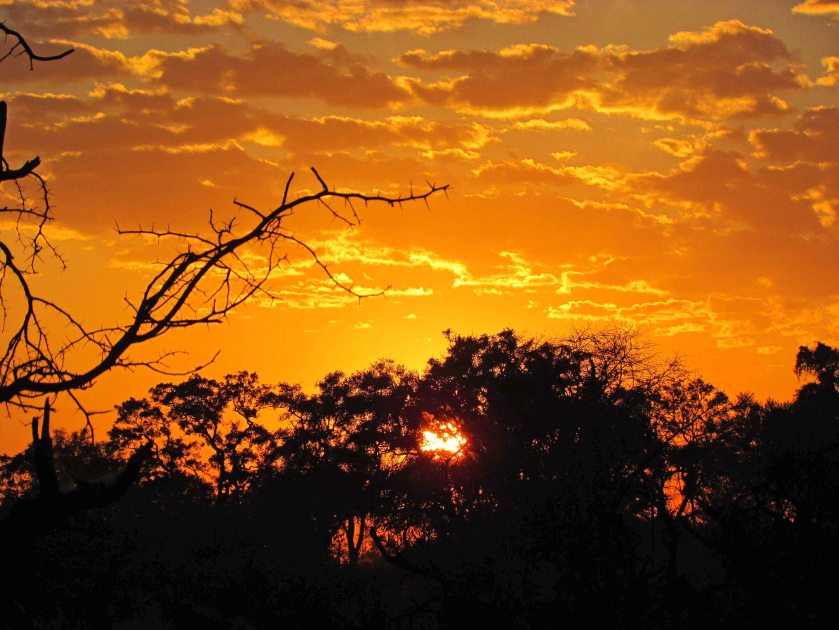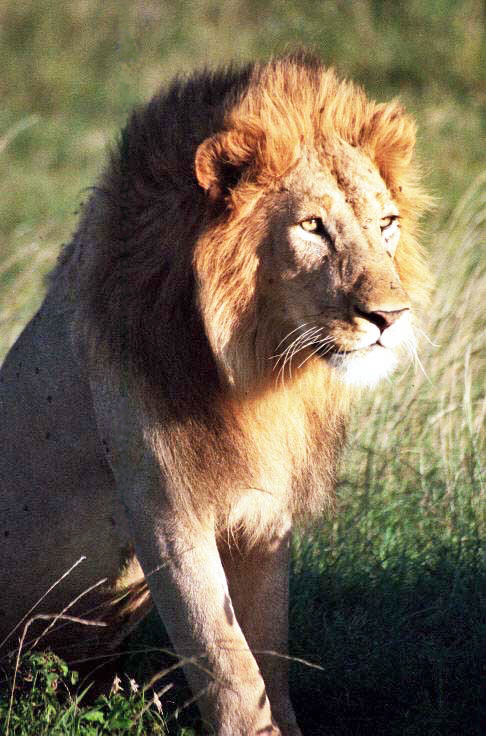“Today we track lion on foot,” Syd says. It’s our final test, the one that lets us know whether we’ll graduate or not from our game-ranger course.
Our small band climbs from the Rover and starts surveying the ground. There are lion tracks here, all right.
“Which way?” Syd asks. We point variously in the same general direction. “Okay, ready?”
We scuff our feet and look around. Syd hefts the rifle from its rack on the dash and our eyes follow his motions as he loads it. That clenched spot in my chest relaxes a little.
Syd and Bernardo usher our silent group away from the road and into the bush as we follow the tracks. Bernardo takes up the rear.
“I am here to stop you from running,” he says with a small smile. Eight people marching in a line and stepping on each other’s heels are not easily identifiable as prey to a lion. But any single one of us dashing way from the group would trigger a hunting response: “Look! Breakfast! And it’s fat and slow!”
We step literally in the lions’ tracks. They are about three-fourths the length of my boots. They are so fresh we can see where the claws have sunk into the sand and made deep slash marks at the front of their pads.
Slowly we make our way through mixed scrub and across pockets of dry, withered grass, stopping frequently to listen for the calls of francolins and baboons, the early-warning radar for lions.
Syd picks up a handful of sand and lets it fall through his fingers, testing. A fluttering wind blows from the right direction, into our faces. If warned by our smell, the lions might decide to swing around behind and follow us. Bernardo keeps glancing backwards, as do I, the last one but for him in our column. Even though it’s fall and many of the scrub thorns have lost their leaves, we can’t see very far ahead. Syd and Bernardo occasionally confer back and forth in low voices, speaking in Shangaan. We probably don’t really need to know what they are saying.
Just past several gullies gouged into the sand by rain, the tracks disappear into a thicket. Syd stops and listens intently, then sweeps his arm to the right. We bypass the thicket, perfect for ambush, and see if lions have emerged on the other side.
In the open, grassy area beyond, our line bumps to a halt. “See them?” Syd asks.

As if on cue, two heads pop up.
Luckily, even though my heart leaps, my legs do not.
The lionesses are under trees on the far side of the field. They are lying down, but our invasion has made them curious. They stare at us, open-mouthed, little question marks nearly visible above their heads. The whir of a camera reminds me that mine is dangling around my neck. Through its telephoto the lions look less dangerous, more relaxed, squinting at us.
Then, off to the right, another lion roars and Syd’s eyes widen in surprise. A low “Tsssssss,” escapes between his teeth. There are more lions here than we have seen tracks for. Everyone’s head, including those of the lionesses, swivel in the direction of the roar.
Almost simultaneously a white bakkie, a mini-pickup, bounces into view near the lionesses and stops there. The woman driver surveys the two lions with binoculars and writes something in a notebook. Bored with it all, they lie back down.
Momentarily distracted from the fact that there are lions to the left and lions to the right, we ask Syd, “Who’s that?” Against all training, we have condensed into a tight ball behind him. Even Bernardo has moved up.
Syd still stares in the direction of the roar. “The ecologist,” he says, “she works in the reserve.”
The bakkie leaves the lions and rattles over the rough ground to where we are.
“Morning,” the ecologist nods to each one of us in slow motion. I wonder to myself if the lion that roared is moving in our direction.
She looks at Syd. “There’s a male about a quarter mile up the road. Be careful where you walk.”
“Is it?” he says, “thanks.” Their exchange is so matter-of-fact that it sounds as if they’re discussing potholes.
“Right then,” she says and the bakkie joggles off. Not even an offer of a lift.
Bernardo and Syd have a short conversation in Shangaan. Then Syd says, “We go back the same as we came. Bernardo goes to get the Rover.”
Bernardo leads and Syd provides the rearguard. As soon as we move, the lionesses’ heads pop up again and follow our exit. We move as one, marching in step, our spines expectant of fang and claw. Once we’re out of view behind clusters of brush, Bernardo trots off, and I am now in the lead, careful to back track our own footprints.
Soon we’re in the Rover headed again to the clearing. The male has not roared again. One of the lionesses opens her eye as we drive up, then shuts it again and flattens her ears. We are an annoyance to her afternoon nap but nothing to get excited about; not like whatever that strange beast was that just left.
Syd tells us that these sisters are the only survivors of a pride that once ruled this territory. Another pride recently moved in and killed their relatives. That was the reason they did not answer the male lion. We were lucky one more time: if they had answered, he would have come running.
One of the sisters has recently been in a fight. She has a wound on her shoulder and has not eaten while healing. Her ribs are showing.
“They do not bring food to each other,” Syd says. “She has to be well enough to hunt.”
We watch the sisters as they nap. We have evolved from being possible prey to compassionate observers, all because we’re sitting in our trusty Rover.
“Will they make it?” one of us asks.
“Do you feel sorry for them?” someone else adds.
“Yes,” Sid says, “yes. But that is just my feeling. If they move to another territory, they will be okay.”

The lionesses nap side-by-side. Without opening her eyes the healthy one raises a front leg and drapes it over her sister’s neck.
Driving back to camp at dusk, we find a male lion awakening from an afternoon nap. According to Syd this lion is very young, trying to move into a new territory, and challenge the two males who recently took over. He has a black punkish stripe in his still-growing mane and no scratches on his nose. He’s not far from where we found the sisters and might be the lion who roared. He blinks at us sleepily, then looks off into the distance, his yellow eyes still not completely open.

As it gets darker we find the eyes of bushbabies reflecting our spotlight like bright Christmas ornaments in the trees. They are distant cousins of ours, using their quick hands and enormous eyes to forage for fruit, insects and bird eggs at night. Long shaggy tails provide balance as they leap from branch to branch, dodging the quick flicks of light we direct at them. We catch glimpses without blinding them.
Syd stops the Rover by a bush. “See him?” Our heads swivel in all directions. I don’t see anything but bush.
Illuminated by the headlamps on the Rover, Syd climbs out and walks over to a round-leafed teak. He reaches up and suddenly a Flap-necked chameleon comes into focus right by his hand. It is a perfect mimic of the leaves on the teak.
We shake our heads and smile at each other.
Back at camp we’re presented with our certificates of completion for our short three-day course.
“Don’t worry about your job, Syd,” we tell him, “none of us will ever be as good as you are.”
He smiles quickly behind his hand, then kicks at the wood in the fire. “Did I tell you about the leopard that jumped into the Rover last year……….”












